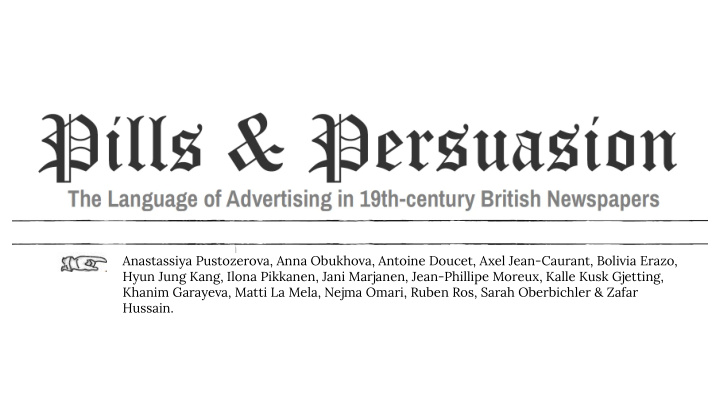



Anastassiya Pustozerova, Anna Obukhova, Antoine Doucet, Axel Jean-Caurant, Bolivia Erazo, Hyun Jung Kang, Ilona Pikkanen, Jani Marjanen, Jean-Phillipe Moreux, Kalle Kusk Gjetting, Khanim Garayeva, Matti La Mela, Nejma Omari, Ruben Ros, Sarah Oberbichler & Zafar Hussain.
1. Introduction: Background and Research Questions
Why should we study newspapers? Newspapers collect information about social, cultural and political events in a more detailed way than any other public record from the past. Advertisements are an especially interesting section in which readers are being persuaded to buy or sell something.
Why The Morning Post? The Morning Post is a newspaper published throughout the nineteenth century in London from 1772 to 1937. This newspaper seems relevant to us to study the issue of advertising because it presents a variety of announcements: upcoming theatrical performances, recently published books, miracle drugs, property for rent, horses for sale, furniture and paintings auctions , as well as many other goods and services. It had a conservative profile and a large circulation. The editors specifically wanted to brand it as serious, not an ad paper.
Our Research Themes 1. The presence of ads in newspapers 2. The language of persuasion in advertisements 3. Medical advertisements through the prism of gender 4. Job advertisements, class and societal change
2. Approach during the Hackathon
Working in smaller groups Two meetings every day Interlinking blog posts, the poster, and the final presentation Using our experience of doing qualitative newspaper research Videos & Twitter
3. Results
1. The Presence of Ads in Morning Post 1800–1900
The Presence of Ads in Åbo Underrättelser 1824–1890 Only a handful of Finnish newspapers have ad segmentation , none in 1892-1910! ÅU 1820s–1840s: notifications; ads look like any other text content ÅU 1850s: transition: amount of other content rises ÅU: 1860s → the newspaper gets a more modern outlook (three columns, ads easy to distinguish by the eye)
1. The Development of Ads in British Newspapers 1800–1900 Country level City level Paper level https:/ /public.tableau.com/profile/zafar2483#!/vi https:/ /public.tableau.com/profile/zafar2483#!/vi https:/ /public.tableau.com/profile/zafar2483#!/vi zhome/NewspapersandAdsTextDensity/Dashboard zhome/NewspapersandAdsTextDensity/Dashboard zhome/NewspapersandAdsTextDensity/Dashboard1 3?publish=yes 2?publish=yes ?publish=yes
1. The Presence of Ads in Morning Post 1800–1900 (Hindle, 1937)
2. The Language of Persuasion in Advertisements What linguistic strategies were used for persuading people into buying or using? Gotti (2005). Advertising discourse in eighteenth-century English newspapers. Leech (1966). English in advertising: A linguistic study of advertising in Great Britain. Lyna & Damme (2009) A strategy of seduction? The role of commercial advertisements in the eighteenth-century retailing business of Antwerp.
Miller, George A. (1995). WordNet: A Lexical Database for English. Communications of the ACM Vol. 38, No. 11: 39–41.
3. The Pills that Cure Everything - Drug Advertisements Thomas Richards,The Community Culture of Victorian England. Advertising and Spectacle 1851-1914, Stanford 1999. History of Advertising Regulation in Communication Law and Ethics. An open-content course for Radford University COMS 400 Students and others [https:/ /revolutionsincommunication.com/law/?page_id=730], 21.05.2019. Turner, Ernest Sackville. The Shocking History of Advertising , Great Britain 1965. pp. 61-64
Pills for women or men? Distribution of gender related keywords in medical advertisements over time
Different sexes, different (amount of) diseases?
Different sexes, different (amount of) diseases?
Descriptive Language in Female Drug Ads?
Descriptive Language in Male Drug Ads?
3. Job Advertisements, Class and Societal Change? Building on our work, linking the pieces together: most sought occupations in newspaper ads / HISCO categories ● requirements connected to different occupations ● social and cultural expectations regarding these jobs ● HISCO (historical international classification of occupations) linked data: UK: Mooney 2016; Basten 2016. Fin-Swe: Petri Roikonen (UH), Semantic Computing Research Group (Aalto)
“A skillful and totally sober machine user” (ÅU) How: recruitment-related keyword searches (needed / requested / recommended) collated with a list of occupations extracted from HISCO (a historical international classification of occupations) in the classified ads corpus (BLN) and articles categorised as advertisements (Finnish Nat. Library / ÅU)
Job Announcements in The Morning Post By HISCO classification
Job Announcements in Åbo Underrättelser By HISCO classification
Job Announcements in Åbo Underrättelser Top 15 occupations
4. Current problems
Problems: OCR Mean OCR Quality of News Articles and Advertisements in 19th Century British Newspapers
Problems: Article Separation - British Newspapers
5. Plan for Future Research
Themes for Future Research Typology of the different newspapers ● Trajectories of newspapers. ● Quantify persuasive rhetorical tropes. ● Medical/drugs and hysteria ● Marketing strategies ●
Dashboards Newspapers and Cities: https:/ /public.tableau.com/profile/zafar2483#!/vizhome/NewspapersandAdsTextDensity/Dashboard1?publish=yes Newspapers and ads text density: https:/ /public.tableau.com/profile/zafar2483#!/vizhome/NewspapersandAdsTextDensity/Dashboard2?publish=yes Total text vs ads text of a newspaper: https:/ /public.tableau.com/profile/zafar2483#!/vizhome/NewspapersandAdsTextDensity/Dashboard3?publish=yes
Problems: Article Separation - Finnish Newspapers Only a handful of newspapers have advertisement segmentation. The validation revealed that ad segments vary from a single word to several advertisements grouped together. Alternative solutions? -Page division – create a corpus that contains the first & the last pages -Segmentation in other txt-files? -Using ÅU data for segmenting other newspapers?
Recommend
More recommend